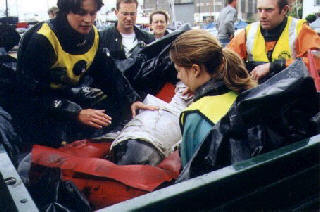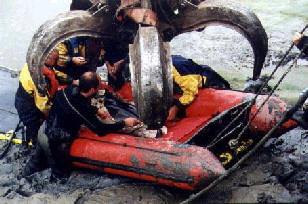|
Initially, her response was quite favourable, as she made strong, powerful movements of her tail fluke in the water. Her breathing rate, however, remained high at between 9 and 11 breaths per minute, although it did dip on one occasion to 6 breaths per minute. Blood samples were taken by James half an hour after arrival and an antibiotic, enrofloxacin was administered (long acting antibiotics were intended to be used, but the bottle smashed in the boat). A triangular depression was now noted under her head, where the skin was rather wrinkled and dry, and occasionally discoloured brown. One possible explanation is that she had come in contact with a caustic material as she lay in the mud in Colchester. Attempts were made periodically to see how well the animal supported herself in the water: each time she was able to support herself without listing, but appeared disorientated, often turning towards shore and her swimming movements were not coordinated. The breathing rate remained high and her eyes were now closed and she developed a slight list to one side. Her reflexes remained rather sluggish and her jaw tone was rather slack. Her mucous membrane colour remained satisfactory.
At 7pm, James administered an anti-inflammatory (carprofen) due to increasing concerns over possible muscle damage, despite stranding on soft mud, and to see if this made any noticeable difference to her behaviour. The animal did appear possibly to make more coordinated movements after this point, but it is impossible to say if this was directly an effect of the drug. The breathing rate, however, remained high at 10-13 breaths/minute and now the animal was exhibiting mild muscle tremors over the chest. At 7.15 pm, due to concerns over the time of day, with little more than an hour’s good light left, the persistently high breathing rate and the perceptible decline in the animal’s condition, a final assessment was made of the animal, with a view to euthanasia if this was not positive. Again, hands were withdrawn and she was observed unsupported: her swimming did appear a little stronger, although she again veered round to point towards the beach. It was at this point that the animal caught everyone unawares and put in a strong spurt of swimming, getting way from her handlers and it was impossible to retrieve her.
A watch was mounted for the next hour and a half and she was observed tacking up and down parallel to the shore, over a hundred metres out, diving often for over a minute at a time. She was lost from sight in the failing light and the watch had to be called off. Ian Black of English Nature, who had accompanied us through the event, agreed to check the beach that night and in the morning. On Sunday, despite extensive searches of the sandbanks and shore by walkers and boats, she was not found again. Results of blood samples revealed no evidence of muscle damage, but she was a little anaemic. There was no evidence of infection, but the normal white blood cell counts do not necessarily rule out a bacterial lung infection, as work in the States has illustrated that an effective immune response to chronic lung infections often is not mounted.
BDMLR is grateful particularly for the hard work put in by the fire brigade and the support received from the crane driver, English Nature and the RSPCA. However, there was little confidence amongst those involved that this animal was a suitable candidate for release at the stage she was ‘released’ and it was unfortunate that she had got away from her handlers at the time she did. A great deal was learned from the episode, however. In particular, this stranding highlighted the need to be able to assess and treat stranded cetaceans in a controlled environment over a much longer period of time than many refloatations allow. The need to have thermistor probes readily available even for animals as small as an adult harbour porpoise also was emphasised and this is being addressed. Although this animal had a characteristic scar on its chest wall, the event also highlighted the need to be able to tag an animal even for short term monitoring. Biodegradable ribbon has been obtained, but attempts to assess its suitability by trialling it on captive pinnipeds have not yet commenced. This will be chased up.
James Barnett
BDMLR Veterinary Director
Top
|

